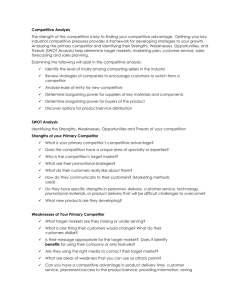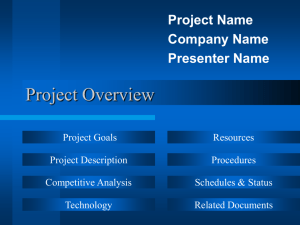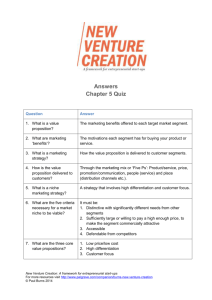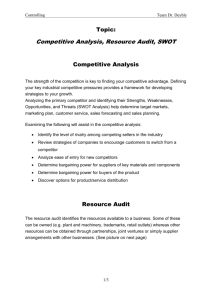Understanding your market/industry Chapter 4 Word Document
advertisement
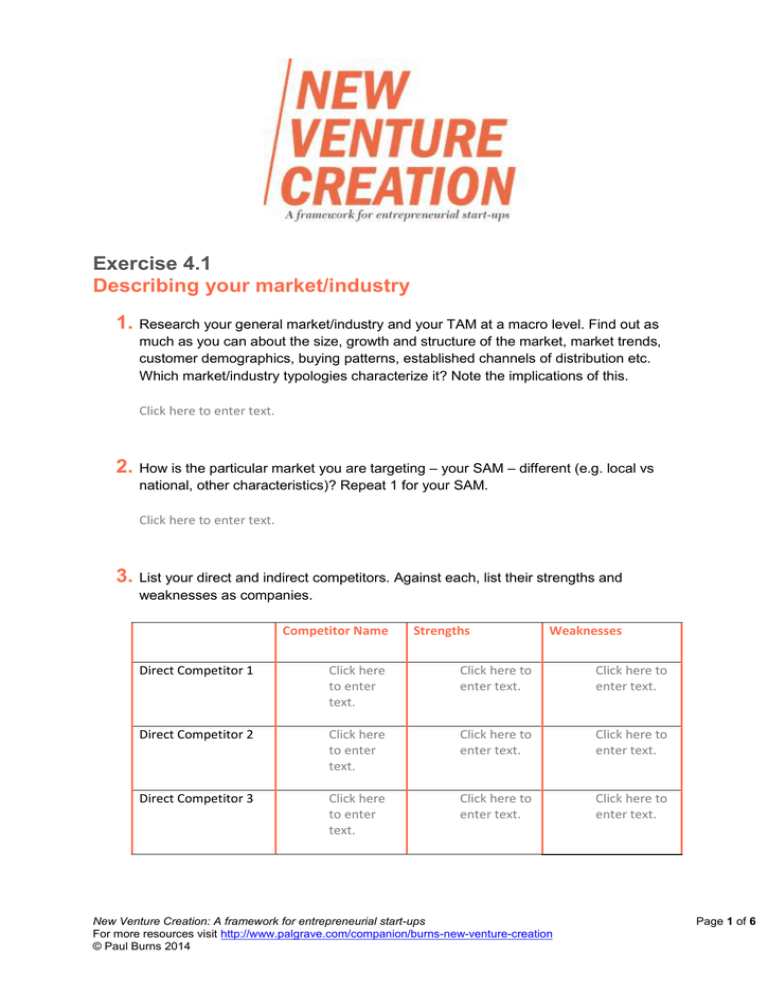
Exercise 4.1 Describing your market/industry 1. Research your general market/industry and your TAM at a macro level. Find out as much as you can about the size, growth and structure of the market, market trends, customer demographics, buying patterns, established channels of distribution etc. Which market/industry typologies characterize it? Note the implications of this. Click here to enter text. 2. How is the particular market you are targeting – your SAM – different (e.g. local vs national, other characteristics)? Repeat 1 for your SAM. Click here to enter text. 3. List your direct and indirect competitors. Against each, list their strengths and weaknesses as companies. Competitor Name Strengths Weaknesses Direct Competitor 1 Click here to enter text. Click here to enter text. Click here to enter text. Direct Competitor 2 Click here to enter text. Click here to enter text. Click here to enter text. Direct Competitor 3 Click here to enter text. Click here to enter text. Click here to enter text. New Venture Creation: A framework for entrepreneurial start-ups For more resources visit http://www.palgrave.com/companion/burns-new-venture-creation © Paul Burns 2014 Page 1 of 6 Click here to enter text. Indirect Competitor 1 Click here to enter text. Click here to enter text. Click here to enter text. Indirect Competitor 2 Click here to enter text. Click here to enter text. Click here to enter text. Indirect Competitor 3 Click here to enter text. Click here to enter text. Click here to enter text. 4. List the strengths and weaknesses of the products or services they produce that compete with yours. Direct Competitor 1 Service/Product 1 Strengths Click here to enter text. Weaknesses Click here to enter text. Service/Product 2 Click here to enter text. Click here to enter text. Service/Product 3 Click here to enter text. Click here to enter text. Service/Product 1 Strengths Click here to enter text. Weaknesses Click here to enter text. Service/Product 2 Click here to enter text. Click here to enter text. Service/Product 3 Click here to enter text. Click here to enter text. Service/Product 1 Strengths Click here to enter text. Weaknesses Click here to enter text. Service/Product 2 Click here to enter text. Click here to enter text. Service/Product 3 Click here to enter text. Click here to enter text. Strengths Click here to enter text. Weaknesses Click here to enter text. Direct Competitor 2 Direct Competitor 3 Indirect Competitor 1 Service/Product 1 New Venture Creation: A framework for entrepreneurial start-ups For more resources visit http://www.palgrave.com/companion/burns-new-venture-creation © Paul Burns 2014 Page 2 of 6 Service/Product 2 Click here to enter text. Click here to enter text. Service/Product 3 Click here to enter text. Click here to enter text. Service/Product 1 Strengths Click here to enter text. Weaknesses Click here to enter text. Service/Product 2 Click here to enter text. Click here to enter text. Service/Product 3 Click here to enter text. Click here to enter text. Service/Product 1 Strengths Click here to enter text. Weaknesses Click here to enter text. Service/Product 2 Click here to enter text. Click here to enter text. Service/Product 3 Click here to enter text. Click here to enter text. Indirect Competitor 2 Indirect Competitor 3 Exercise 4.2 Assessing the degree of competition The Five Forces model can be used to assess the degree of competition you face in an existing market/industry and, hence, the threat to your profitability. However, there may be things you can do to mitigate this threat. Complete the table on the following page, for each of the forces: 1. Assess the threat to industry profitability. 2. Note the implications of this for you. 3. List the actions you need to take to ensure that you can avoid or lessen the effect of high threats to profitability. 4. List the actions you need to take to create a sustainable position that means others cannot copy these actions New Venture Creation: A framework for entrepreneurial start-ups For more resources visit http://www.palgrave.com/companion/burns-new-venture-creation © Paul Burns 2014 Page 3 of 6 Competitive Force Rivalry Among existing firms (e.g. number of competitors, industry structure, degree of product differentiation etc.) Threat of substitutes (e.g. degree of product differentiation, switch costs etc.) Threat of new entrants (e.g. barriers to entry, switch costs, economies of scale, access to distribution channels, degree of differentiation, capital requirements etc.) Bargaining power of suppliers (e.g. switch costs, supplier concentration, attractiveness of substitutes etc.) Bargaining power of buyers (e.g. switch costs, buyer concentration, product differentiation, buyers’ costs etc.) Threat to Industry Profitability [Low, Medium, High] Choose an item. Implications Actions to lessen/avoid threats Actions to sustain position Click here to enter text. Click here to enter text. Click here to enter text. Choose an item. Click here to enter text. Click here to enter text. Click here to enter text. Choose an item. Click here to enter text. Click here to enter text. Click here to enter text. Choose an item. Click here to enter text. Click here to enter text. Click here to enter text. Choose an item. Click here to enter text. Click here to enter text. Click here to enter text. New Venture Creation: A framework for entrepreneurial start-ups For more resources visit http://www.palgrave.com/companion/burns-new-venture-creation © Paul Burns 2014 Page 4 of 6 Exercise 4.3 Assessing your market/industry future 1. Undertake a SLEPT analysis on your market/industry to identify key influences or events that might affect it over the next five years. Click here to enter text. 2. Using the market/industry analysis from Exercises 4.1 and 4.2, construct three scenarios– ‘best’, ‘worst’ and ‘most likely’ cases – that reflect how these influences or events might impact upon the trends in the industry. Remember to factor in the existence of your firm. • Will the industry expand or contract? Will it consolidate or fragment? • Are the main dimensions of competition changing and what is driving this change? • Will sectoral, performance and/or customer conventions change? • Will competition intensify or will products become more differentiated? • How will direct and indirect competitors be affected? • How might they react to your existence? • How will their reaction affect you? Best Scenario Click here to enter text. Worst Scenario Click here to enter text. Most Likely Scenario Click here to enter text. 3. Brainstorm to explore how you might react to these trends and competitors. What strategies might you adopt? Click here to enter text. Will you need to modify or change your product/service idea? Click here to enter text. New Venture Creation: A framework for entrepreneurial start-ups For more resources visit http://www.palgrave.com/companion/burns-new-venture-creation © Paul Burns 2014 Page 5 of 6 Will you need to identify and enter new markets? Click here to enter text. 4. List the critical success factors for your business – the things you need to get right to ensure your survival and success. Click here to enter text. New Venture Creation: A framework for entrepreneurial start-ups For more resources visit http://www.palgrave.com/companion/burns-new-venture-creation © Paul Burns 2014 Page 6 of 6
